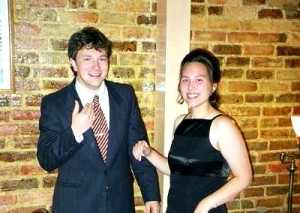We’ve been in Spring cleaning mode here around the house. Angela went through our old file cabinet, combing over records for the past decade plus. We also both chucked most of our papers and files from college. That alone ended up being ten boxes to take to the document shredding & recycling place.
In the process, I ended up with a rather large pile of 3.5″ floppy disks to get rid of. I decided to go through them and copy any files before we had them destroyed. Of course, we actually don’t own anything with a 3.5″ floppy drive! Even my old linux box in the garage only has a optical drive. Fortunately, Angela’s dad has a USB floppy drive he was able to loan us.
So, in the process of going through some of the disks (many of which included programs for obsolete operating systems), I managed to find a few gems:
- Lots of photos from around 1998–99, when Angela and were first dating and she was going off to pharmacy school in VA. It probably goes without saying, but we’ve aged a bit in the past decade.

Our first ever big date, almost 11 years ago. - The first help document I ever wrote for software. It was for a DOS program called Plane Frame & Truss (PFT, for short, because filenames back then couldn’t exceed 8 bytes). It is written in a very snarky voice; probably not something I’d try and reproduce in my current writing (okay, maybe here):
How to use Dr. Noel Tolbert’s Plane-Frame-Truss Program (PFT)
By Jason ColemanFirst of all, PFT is not user-friendly, regardless of what Big-Daddy-Tolbert may say about it. However, if you are using PFGTAB (the quasi-graphical version), simply read everything it tells you until you are more comfortable with the program. The questions the program asks are not always clear at first, so take your time with them.
How PFT works: (This is more-or-less from the horse’s mouth)
This will cover, for the most part, how to use the graphical interface, PFGTAB. You have to be at an MSDOS prompt, and not simply in a Windows Shell. In a windows shell, you can only run a program once, and then the shell more-or-less quits, and when using PFT, you actually have to run two programs consecutively. That’s one of the many non-user-friendly features of PFT.
- The first program I ever wrote in Visual Basic (or anything that had a GUI, for that matter). It was a program for Advanced Mechanics of Materials grad. level course which would determine the stresses in a curved beam member under a specific loading. It wasn’t exactly anything very useful (unless you need to design clamps for a living), but it also didn’t look too bad for a first attempt:

Curvbeam.exe’s screen.
So we found a few nerdy treasures from our past lives. That’s one of the fun things about cleaning out so much of that sort of stuff: you find the things that really mean something and can put them somewhere you can access, instead of buried in a tomb of junk.
